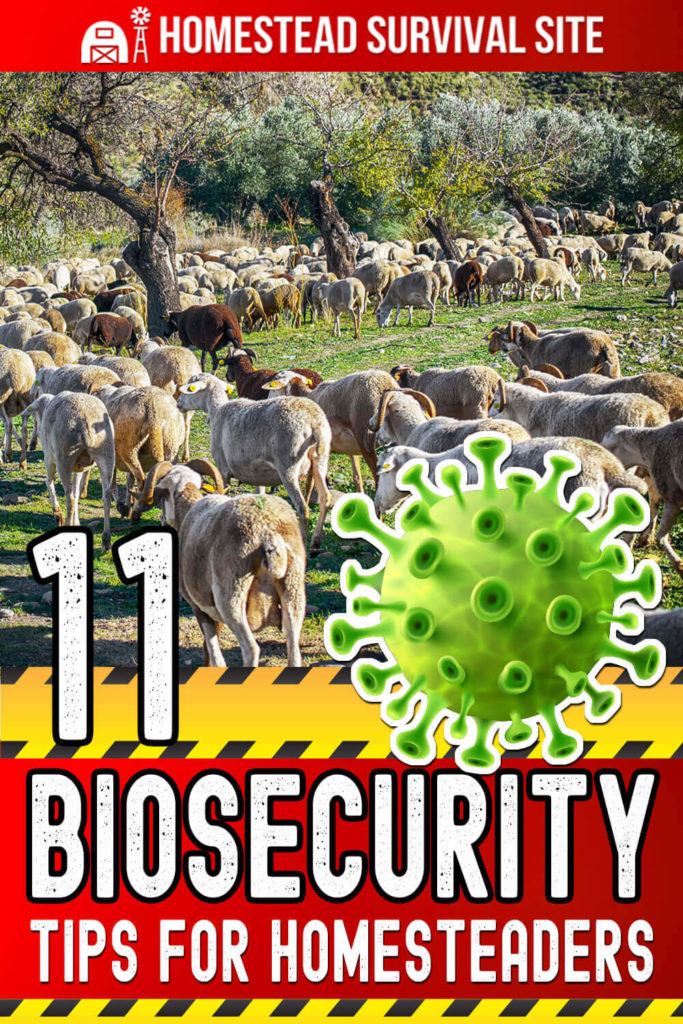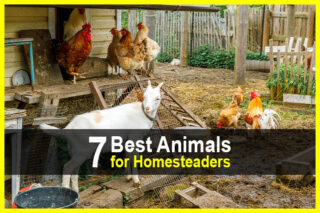Estimated reading time: 6 minutes
Homesteaders may not think about biosecurity when they get up in the morning. But if you have livestock and pets, you probably should. Having good safety measures in place is one of the first lines of defense for your animals. So, continue reading to learn why good biosecurity is necessary for your homestead.
What is Biosecurity?
So what is biosecurity, and how does it relate to life on the homestead? Biosecurity is: “procedures intended to protect humans or animals against disease or harmful biological agents.”
Most people hear “biosecurity” and think of experimental labs. They envision people running around in white Hazmat suits. This scenario isn’t all science fiction. It is, in fact, a form of biosecurity at the industrial level. Ordinary people can put their own biosecurity measures in place, just not to that extreme.
Homestead biosecurity involves keeping your animals disease-free while also maintaining clean facilities. Ensuring your own homestead’s health also goes a long way in protecting that of your neighbors.
Want to save this post for later? Click Here to Pin it On Pinterest!
Why is Biosecurity Important?
Modern society loves to be on the move. This means animals may be on the road almost as much as their human counterparts. Vacations, doggy daycare, fairs, breed shows, and livestock auctions are common destinations.
Unfortunately, disease, viruses, and other harmful agents also hitch rides to these places. They may travel on an animal, a vehicle or trailer, or even on a person and their clothing. Once an infectious agent is in place, it doesn’t take any time at all for it to spread.
Biosecurity is not just for big farms or producers. If you only have pets or a small backyard egg flock, you still need to have good habits to protect those animals. It only takes one infected animal to start a nasty chain of events for you and eventually your neighbors.
How Do I Practice Good Biosecurity on My Homestead?
Implementing effective biosecurity measures on your homestead is easy and inexpensive. Start now to minimize the risks that could destroy your animals and possibly your livelihood. The tips below will help get you started.
Isolation / Quarantine
Isolation
One of the most effective biosecurity measures is to isolate any sick animals. Animals showing signs of illness or disease should be immediately isolated from others. They should remain there until the problem is solved and the animal is once again healthy.
Quarantine
Quarantine new animals or those returning from shows or breeding sessions. As in isolation, a 30-day minimum quarantine should be a part of your standard routine. Washing, deworming, and treating your animals may also be a good idea at this point.
Traffic Control
Footwear
Feet – both humans and animals spread many contaminants. Several preventative measures help lower this risk. These include disinfecting boot washes and step-in trays, dedicated footwear, and disposable plastic shoe coverings.
Limited Visitors
Many homesteaders want to show off their hard work, but limiting barn visits may be a better practice. If you are giving a tour, ensure that your visitor has not been somewhere where disease is prevalent. It is also a good idea to know how your visitor cares for their own animals and facilities before allowing them access to yours.
Stay Home Doggy
Dogs are into everything at home and elsewhere. If there is illness or disease present, it is a given that the dog will find it. They could carry it to your place and spread it. There is no reason for non-resident dogs to roam around your place. On the other hand, keeping your animals at home is a good idea.
Sanitation
We’re all taught to wash our hands regularly and use hand sanitizers. Set up a handwashing station near all of the faucets. Place bottles of sanitizer anywhere convenient and appropriate.
Bleach is still a top cleaning and disinfecting solution. Use it regularly to keep your equipment and facilities sanitary. Other farm-approved disinfectants in both liquid and spray formulas are available.
Clean and sanitize pens/cages that have held ill or quarantined animals. Do the same with anything in the area that may have been in contact with them. This includes all equipment, tack, and tools – especially those that have left the property and returned.
Containment
Many homesteaders choose to let their animals “free-range.” This term’s definition has changed over the years, but it still means that the animals aren’t contained. As a result, you have no control over what your animals will come across.
If you must let your animals roam, be sure there are no hazards, biological or physical, for them to find. Standing water, rotted vegetation/feed, and wildlife are examples. Areas that have been sprayed or poisoned are another concern. Finally, other roaming ill or dying animals pose a serious threat.
Controlling Wildlife
Water Sources
Keeping wildlife away from your animals’ water sources is an important safety measure. Wild animals carry diseases that may infect and even kill your domestic livestock. It is also a good idea to provide several different watering stations when possible.
Facilities
Mice, rats, and other rodents are common homestead pests. Keep critters out of your feed and barns to help keep diseases from spreading. Good fencing and netting (for poultry) will also deter unwelcome visitors.
Safe Breeding Sources
Keeping your own breeding bull, ram, or boar isn’t always possible. This means you need to invite one in to visit your females or send them out to visit. As far as biosecurity risks go, this is a big one.
There are a few ways to deal with this problem other than keeping the males:
- Get to know your local breeders and how they operate or care for their facilities.
- Don’t be afraid to ask for a health certificate on an animal you’re welcoming for a conjugal visit.
- Look into artificial insemination (AI). Then, both animals can safely stay home while still producing offspring.
Share Knowledge
“Knowledge is Power” are words to live by and to keep your animals alive. Share any information with your veterinarian, neighbors, and other homesteaders. Keeping an outbreak a secret is unwise and dangerous. Open communication between growers is essential for you and your fellow homesteaders.
Spread Information, Not Disease
Establish good biosecurity habits and procedures on your homestead. Then start a conversation about it with your friends and neighbors. Sharing what you know with those around you can help all of you keep your animals and your homesteads safe.
Like this post? Don't Forget to Pin It On Pinterest!











Good posting! Living in a secluded forested or dedicated area doesn’t exempt you and yours from airborne, or foot traffic transmission. I am concerned about my flock catching something from wild birds rodents or soil borne pathogens. This is good encouragement for me. Thanks